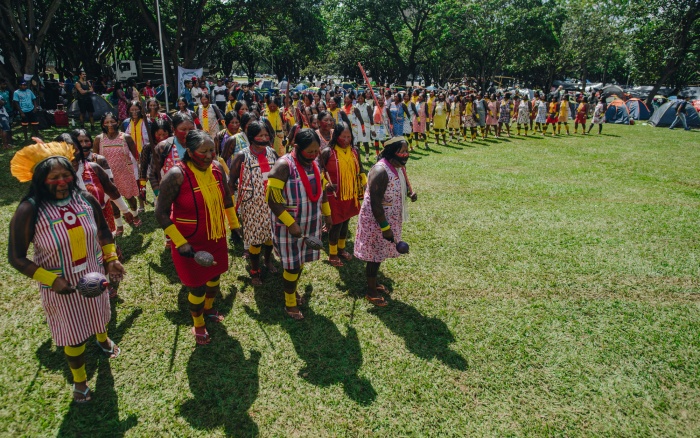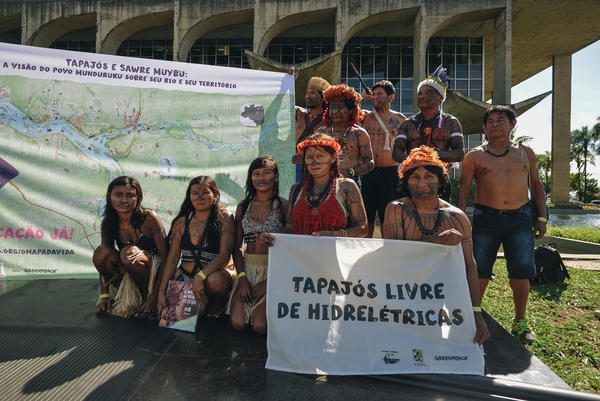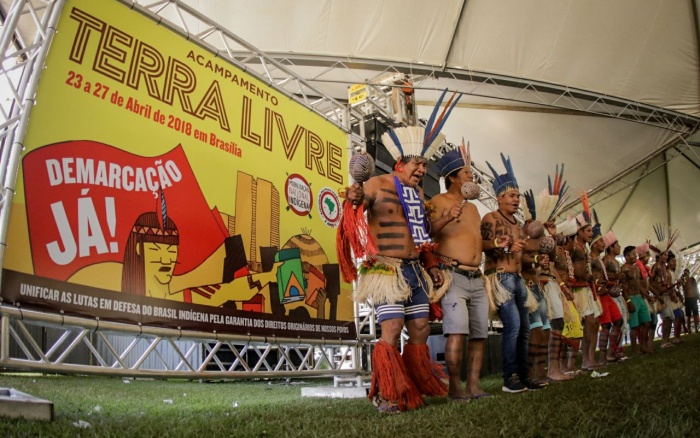- From 23-27 April, 3,000 indigenous people from a hundred groups all across Brazil came together in Brasilia for the 15th annual encampment to demonstrate against government policies and to demand justice. While last year’s event saw police crowd control with teargas, this year’s was peaceful.
- This year’s encampment, like last year’s, was among the largest ever, catalysed by rising violence against indigenous leaders and activists, and by what participants see as the repressive and authoritarian policies of the Temer government and Congress, both of which are dominated by the bancada ruralista, the agribusiness lobby.
- Among other demands, the demonstrators called for demarcation of ancestral lands, guaranteed under Brazil’s 1988 Constitution, but not yet carried out in many indigenous areas. Protestors also asked the government to obey International Labour Organization Convention 169, which Brazil signed, and assures pre-consultation of groups impacted by large infrastructure projects.
- Indigenous women had an exceptionally strong presence at this year’s encampment, and there was further collaboration with traditional riverine group representatives, who in the past were sometimes indigenous opponents. Now, indigenous and traditional people are joining together to prevent the loss of their lands and cultures, and to preserve their way of life.

On 26 April, more than 3,000 indigenous people marched down the broad Avenue of the Ministries in Brasilia, leaving a path of ‘blood’ (red paint) behind them. When they reached the Justice Ministry, they unfurled a giant banner, 24 meters (78 feet) across by 12 meters (39 feet) high, demanding an “End to Indigenous Genocide.” They chanted: “FUNAI [the government’s indigenous agency] belongs to the Indians, not to the ruralists, [the agribusiness elite].”
The demonstrators, representing over a hundred different indigenous groups from all over Brazil, were taking part in the 15th Free Land Camp (Acampamento Terra Livre). They camped for five days in Brasilia’s center and carried out a program of assemblies, cultural events and meetings. Unlike last year, the protests unfolded peacefully, without police repression.
“This trail of blood represents all the violence imposed by the state on this country’s original inhabitants, which continues today through the slow pace at which our land is being demarcated,” said the indigenous leader Marcos Xukuru from Pernambuco state. “Indians are being assassinated and our leaders are being criminalized but, even so, we will always go on resisting and fighting for our rights, as our ancestors have taught us to do.” Brazil has become the most dangerous nation on earth for indigenous leaders, social activists, and environmentalists, as violence and murders have escalated over recent years, a record that has only worsened under the lax law enforcement of the Temer administration.

The indigenous groups were also protesting the decision of Justice Minister Torquato Jardim, announced on 24 April, to appoint a new FUNAI president, Wallace Moreira Bastos, a businessman and religious preacher, who has no experience with indigenous affairs. The previous president was sacked due to pressure from the bancada ruralista, the agribusiness lobby which holds tremendous influence with President Temer and the Congress. Bastos will be the third president in two years in an agency that has seen massive debilitating budget cuts.
Dinamā Tuxá, a spokesman for the Articulation of Brazil’s Indigenous Peoples (APIB), said: “We’ve never heard of this person, we don’t know him, but the main problem is that he’s been indicated [selected] by politicians opposed to what FUNAI should have as its mission – to serve the interests of indigenous peoples as guaranteed by the constitution. For us, it means that FUNAI has ended.”
Among other encampment events, the Munduruku held a protest in front of the Palace of Justice, the seat of the justice ministry, to demand the demarcation of their Sawre Muybu territory – boundary marking required under the 1988 Brazilian Constitution, which the government has delayed for decades. They distributed a publication, entitled: “The Map of Life – Tapajós [River basin] and Sawre Muybu: the vision of the Munduruku people of its river and its territory.” The document, prepared with the help of the NGO Greenpeace, offers a picture of the Munduruku way of life, and describes the sacred sites and forest resources essential for their survival.

The theme of this year’s encampment was “Unite our Struggles in Defense of Indigenous Brazil.” It reflects the indigenous perception that their lands, culture and livelihoods have suffered an unprecedented assault over the last two years, and that they will only survive if all Indian groups act together and, whenever appropriate, in coordination with non-indigenous traditional people whose way of life is also threatened by large infrastructure development projects, including dams, roads, railways and industrial waterways to support industrial agribusiness and mining.
The Catholic Church’s indigenous council, CIMI, calculated that there were an unprecedented number – 33 – anti-indigenous bills making their way through the Chamber of Deputy and the Senate last year. The driving force behind these bills, it said,
was the Parliamentary Farming Front (FPA), popularly known as the bancada ruralista. Made up of over 200 federal deputies and 20 senators, the lobby has long maintained that the country’s indigenous groups occupy too much land.
Indigenous women were very prominent in this year’s encampment. They organized the opening event on Monday 23 April – a three-hour debate in the main tent at which dozens of women spoke. Carolina Rewaptu is the leader of Madzabzé village in the indigenous territory of Marãiwatsédé in Mato Grosso state, from which the Indians were evicted in 1966 only to regain their land, by then heavily devastated, in 2004 after a long struggle. She declared: “We have to speak to the politicians. They want to put an end to our culture, to our religions, to our history. We have to get them to listen.”

Suzana Xokleng, a former president of the National Association of Indigenous Women, and a defender of indigenous women’s rights since the 1990s, said: “There are a lot of women taking part, getting involved in indigenous policies. Before it wasn’t like this.” Holding hands with Tuíre Kayapó, another veteran of the women’s indigenous struggle, she said: “We are grandmothers, great-grandmothers, and we’re here. We are going to unite, us indigenous women, to save our traditional land.”
While the Camp was underway, the Chamber of Deputies was holding a public hearing about Ferrogrão, the new grain railway planned to carry soy from the town of Sinop in Mato Grosso to the port of Miritituba on the Tapajós River. The rail line will run parallel to the BR-163 highway, which already suffers severe traffic jams during harvest season.
Although railways are generally regarded by environmentalists as less harmful than roads, this new 600-mile railroad, if it goes ahead, will have an impact on 48 protected areas, including indigenous reserves and conservation units. This time the affected peoples want to be consulted before the final route is decided and not afterwards, as has happened with so many Brazilian infrastructure projects in the past.

Both indigenous groups and traditional riverine populations sent representatives to the hearing, putting into practice the new unity strategy promoted at the encampment.
The president of the association of the non-indigenous Montanha-Mongabal community, Ageu Lobo Pereira, said that the International Labour Organization’s Convention 169, of which Brazil is a signatory, lays out clearly how the consultation should happen: “I keep thinking what it will be like for future generations threatened by these big projects,” he said. “Before they start work, they have to hold a prior consultation in the location, get to know our way of life, the way of life of the people who live by the river and in the forest.”
Maria Leusa Munduruku, a forceful Munduruku woman warrior, demanded: “Where is the prior consultation? Is it only us who know of our right to have this consultation? Are we going to have to give lessons to the deputies and the authorities? Have you lost your copy of Convention 169?”
Tarcísio Freitas, a spokesman for President Temer, rebutted their demands, saying they were premature: “The problem is that we don’t know yet if RailGrain will happen. We still have to raise the capital.”
Last year’s, and this year’s, Brasilia encampments – the largest on record – are a show of growing indigenous strength, and represent a new spirit of determination. Indigenous women have long taken part in past land and civil rights struggles, but rarely have they taken leadership roles, as they are doing today, with their warrior spirit evident in many speeches. “My hair is already going white from travelling so much, leaving behind my sons and daughters,” said Isabel Xerente. “But we will go on fighting, defending our forest, our trees, our jungle, our right to walk on our land. If we were frightened, we wouldn’t be here.”
FEEDBACK: Use this form to send a message to the author of this post. If you want to post a public comment, you can do that at the bottom of the page.

